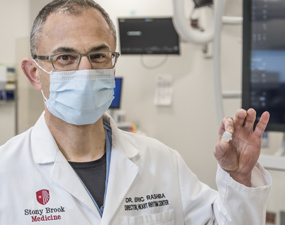Stony Brook University Heart Institute now offers its patients the latest generation of the Watchman FLX™ device, which provides protection from strokes for people who have atrial fibrillation (AFib) that is not caused by a heart valve problem.

- The device, about the size of a quarter, closes off the part of the heart where 90% of stroke-causing clots comes from.
Stony Brook is one of a select number of sites in New York State to offer the new Watchman FLX device — a procedure that requires the combined expertise of a cardiac electrophysiologist (who has the expertise in heart rhythm problems), an interventional cardiologist (who has the expertise in non-surgical catheter-based procedures) and a cardiac imaging specialist (who uses real-time advanced cardiac imaging during the procedure).
People with an irregular heartbeat called atrial fibrillation (AFib), the most common type of heart rhythm disorder, have a five-to-seven percent increased risk of having a stroke compared to people without AFib.
To help prevent strokes, blood thinners such as direct oral anticoagulants or warfarin are prescribed. “Most people do well, but some experience bleeding problems or have other reasons why blood thinners aren’t the best option,” explains Eric Rashba, MD, Director, Heart Rhythm Center at Stony Brook Heart Institute.
The Watchman device provides an alternative to the lifelong use of blood thinners (anticoagulants) for people with AFib by blocking blood clots from leaving the heart and possibly causing a stroke.
Pictured below: Eric Rashba, MD, Director, Heart Rhythm Center; Smadar Kort, MD, Director of Non-Invasive Cardiac Imaging; and Puja Parikh, MD, Interventional Cardiologist in Stony Brook’s Advanced Multifunctional Cath/EP Lab
Advanced Safety, Procedural Performance and Customization
The design of the newer, Watchman FLX device used by the Heart Institute offers significant advantages to the patient, including:
- Advanced safety due to the new framing of the device that allows for more long-term stability and a more complete seal
- Enhanced procedural performance that allows the physician to better maneuver and position the device during the procedure
- A broader size range to permit treatment of a wider range of patient anatomies
The Watchman device has been rigorously studied and has a proven record of safety after more than 150,000 procedures performed worldwide.
“At the Stony Brook Heart Rhythm Center, in the hands of our expert team, we are excited to bring this latest innovation to effectively provide protection equivalent to anticoagulants for preventing strokes and avoiding the risk of serious bleeding,” said Dr. Rashba. “It has saved lives and improved my patients’ quality of life."
Frequently Asked Questions
With AFib, the upper chambers of the heart beat in an irregular rhythm. This disrupts how the heart pumps blood, which can result in blood possibly forming clots in a chamber of the heart called the left atrial appendage, or LAA for short. If a clot leaves the LAA, it can block blood flow to the brain and cause a stroke. More than 90 percent of stroke-causing blood clots that arise in the heart come from the LAA.
Watchman is a “left atrial appendage (LAA) closure implant.” This means that it is a device that gets implanted into the LAA to block blood clots from leaving the heart. The FDA-approved Watchman FLX device is about the size of a quarter. When it is inserted into the LAA, the device expands like an umbrella so no blood can leak out. Then, over the next 45 days, cardiac tissue grows over the implant to permanently block off the LAA.
At Stony Brook, Watchman FLX is implanted by a multidisciplinary team during a minimally invasive, nonsurgical procedure done in the Heart Institute’s procedural suites. With the patient under general anesthesia, we insert a small catheter carrying the Watchman device into the patient’s upper leg, and thread it up into the LAA. We use real-time echocardiograms and x-rays during the procedure to help ensure proper fit and placement of the device.
Implantation of the Watchman device involves the combined expertise of a cardiac electrophysiologist (who has the expertise in heart rhythm problems), an interventional cardiologist (who has the expertise in non-surgical catheter-based procedures) and a cardiac imaging specialist (who uses real-time advanced cardiac imaging during the procedure.
Implanting the Watchman device typically takes less than two hours, and patients are able to leave the hospital after an overnight stay.
Most patients can resume their regular activities within a week.
The Watchman device has been rigorously studied and has a proven record of safety after more than 150,000 procedures performed worldwide. Watchman FLX has a 0.5% major complication rate and 98.8% procedural success.
The Watchman implant is appropriate for people who:
- have AFib not related to heart valve disease
- are at increased risk for a stroke
- are appropriate for short-term, but not long-term treatment with blood thinning medicines such as warfarin (Coumadin) or new anticoagulants (apixaban, rivaroxaban, edoxaban, dabigatran)
- are unable to stay within the recommended blood clotting range while taking warfarin
- have an appropriate reason to seek a non-drug alternative to warfarin, such as a history of serious bleeding, a high risk for falling, or jobs or hobbies that increase the risk for bleeding
Put Your Heart Health First
If you are at risk or if someone in your family has a heart condition, it’s important to schedule a visit with a cardiologist for preventive care. Our cardiologists can help you improve your heart health and/or prevent the progression of cardiovascular disease with a comprehensive heart disease risk assessment and treatment options.
Do something good for your own heart health by taking a free heart health assessment now.
For information and appointments

